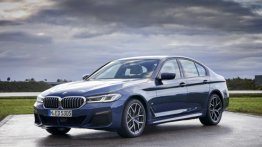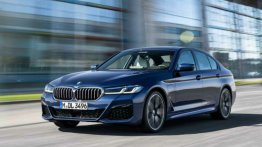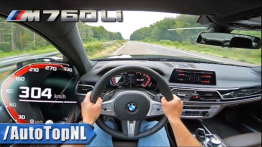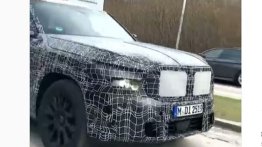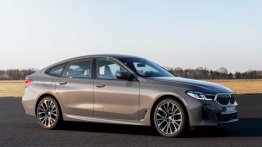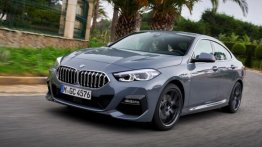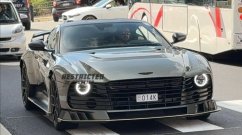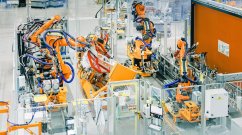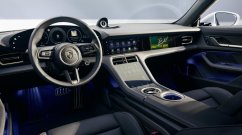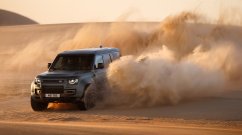First mass-production car to integrate carbon fiber in its body construction.
After endless teasers, spyshots and leaked documents, BMW has finally unveiled the sixth generation BMW 7-Series flagship sedan, ahead of its show debut at the 2015 Frankfurt Motor Show.
[Can't see the video? Head to Youtube]
It brings many "world's firsts" to the table (as a flagship BMW should do), an evolutionary design, an all new platform that features carbon fiber construction, and a chock full of advanced technology that will be filtered down to the company's next generation product lineup.
As seen in spyshots and leaked images, the BMW 7-Series takes an evolutionary step with respect to exterior design. While the new 7-Series doesn't look as striking as the BMW Vision Future Luxury Concept, it does borrow cues from the said concept that is integrated over the design of the outgoing model, thus resulting in a fresher and more modern styling.
Up front, the optional Laserlight headlamps now flow directly into what could probably be the largest pair of kidney grilles (active aero function) in a modern BMW, while the lower fascia features a simple intake running across the bumper with a chrome bar adding a touch of luxury.
At the side, notable changes include extra chrome detailing that starts from the front wings and ends at the lower rear bumper, as well as new side-view mirrors with turn indicators. A sleek set of L-shaped LED taillamps, a sculpted rear bumper, and chrome exhaust tips round up the changes at the rear.
It is the first BMW to be based on the RWD CLAR (Cluster Architecture) modular platform, which will underpin a slew of next-generation models. One of the biggest innovations with the platform in the BMW 7-Series is the integration of industrially manufactured CFRP (Carbon fiber reinforced plastic) in combination with steel, aluminum and plastic, which BMW proudly calls ‘Carbon Core’ technology.
Thanks to the new body construction, the 2016 BMW 7-Series is 130 kg lighter than the outgoing model, thus aiding fuel-efficiency and performance.
Like the exterior, the interior will also look familiar to a BMW enthusiast, but is made more modern and luxurious with design cues from the Vision Future Luxury Concept. The interior design is characterized by a flowing dashboard that is trimmed with wood, chrome and wrapped in two-tone leather.
The 7-Series gets a leather-wrapped multifunction steering wheel taken straight from the concept model, and a next generation instrument display with 3D graphics working in conjunction with the largest BMW Head Up Display offered. It retains the familiar looking gear-shifter (but with an updated design) and reduces the button count in the center console for a clean design. The center console also features a smartphone holder with inductive charging station.
As with the outgoing model, the rear seats are individually power adjustable and features optional infotainment screens behind the front seats. For an airy cabin, it is fitted with an optional SkyLounge panoramic glass roof, with side-mounted LED modules that illuminate an imprinted graphic.
Taking the center stage at the dashboard is the all new iDrive 5.0 infotainment display supporting touchscreen and hand gestures for the first time in a BMW. However, the familiar iDrive rotary controller is still retained for normal navigation across the UI. Hand gestures detected by 3D sensors can be used to adjust the volume or accept/reject incoming telephone calls as well as to call preset contacts defined by the user. The new 7-Series also offers ambient lighting throughout the cabin, which can be customized in an array of colors and brightness levels.
The 2016 BMW 7-Series features a revised engine lineup tuned for greater fuel efficiency and more power. At launch, the only diesel option is the BMW 730d which is powered by a B57 six-cylinder diesel engine making 265 PS (7 PS more than the outgoing model). Fuel efficiency is rated at 22.2 km/L (EU cycle), representing a significant improvement over the previous car's 17.8 km/L.
The petrol lineup includes the i6-powered 740i and V8-powered 750i xDrive. The former packs a 326 hp 3.5-liter straight six-cylinder (B58) sourced from the BMW 340i facelift, while the latter sports a 444-hp 4.4-liter V8 TwinTurbo. The only transmission option is an 8-speed automatic transmission with improved response, fuel efficiency and lower CO2 emissions.The 750i sprints from 0-100 km/h in 4.4 seconds and top out at a limited 155mph, while the 740i manages the 0-100 km/h sprint in 5.5 seconds.
Another variant announced was the hybrid BMW 740e, which gets a 2.0-litre four-cylinder turbo engine paired to an electric motor that draws power from a battery hiding under the rear seats. Combined output is rated at 322 bhp, while the official fuel consumption is rated at 57.39 km/L (EU cycle) and emitting just 49 g/km of CO2. On electric power alone, it is capable of 25 miles of range and a top speed of 75mph top speed.
An air suspension system is offered as standard with automatic self-leveling that enhances the ride comfort and handling. Also in tow are new driver assistance and autonomous driving systems which will become available as options.
The BMW 7-Series is the world’s first mass-produced car that can autonomously maneuver in or out of parking spaces or garages without anyone at the wheel, using the optional display key. It also features the an advanced Active Cruise Control with Stop & Go function and Lane Departure Warning Assistant that takes a step closer to autonomous mobility.
Series production of the sixth generation BMW 7 Series will be underway on 1 July at its plant in Dingolfing, while European sales of the new 7-er are set to commence from October (reportedly), after its debut at the 2015 Frankfurt Motor Show in September.
For the Indian market, the new 7 Series is likely to be launched early next year. Like the current model, it will also be assembled at BMW India’s Chennai facility, which recently has embraced increased localization.
2016 BMW 7 Series revealed in Munich - Press Release
[Can’t see the press release? Head over to Slideshare]



















